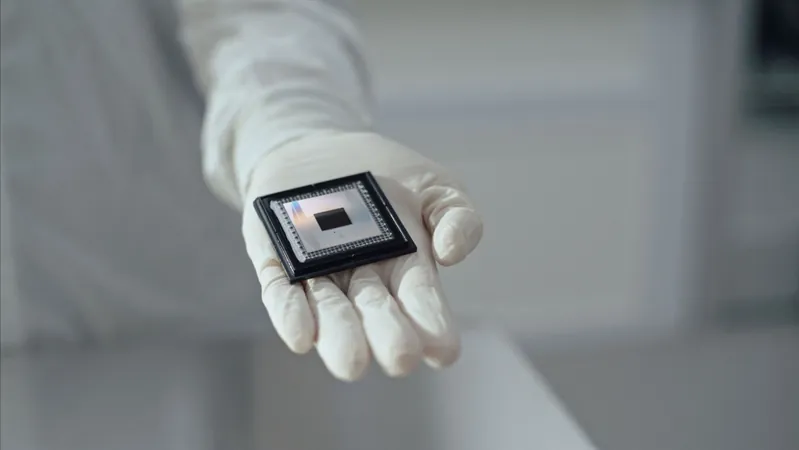
Unveiling Hidden Valleys: Groundbreaking Search for Exotic Particles at CERN
2024-12-11
Author: Amelia
Introduction
In the race to understand the fundamental building blocks of our universe, physicists are embarking on a thrilling journey into the uncharted territory of exotic phenomena predicted by theoretical models. These enigmatic occurrences are thought to exist beyond the confines of the Standard Model (SM) of particle physics, which has, until now, been our best guide in exploring the atom's subtleties.
The Search for SUEPs at CERN
A significant highlight of this groundbreaking research was recently documented by a team of scientists involved in the Compact Muon Solenoid (CMS) experiment at CERN. They reported the first-ever search for a distinctive signature known as soft unclustered energy patterns (SUEPs), a phenomenon theorized to emerge from high-energy proton-proton collisions at the state-of-the-art energy of 13TeV.
"SUEPs represent a tantalizing piece of a larger puzzle that seeks to bridge the gaps left by the Standard Model, addressing mysteries like dark matter and the matter-antimatter asymmetry we observe in the universe," explained Luca Lavezzo, a prominent member of the CMS team.
The concept of SUEPs springs from "hidden valley" theories, initially posited nearly two decades ago by physicists Matt Strassler and Kathryn Zurek. These models suggest a "dark sector" operating with its own unique strong interactions, akin to how quarks and gluons are held together in protons.
Challenges in Detection
Despite their intriguing predictions, these hidden valley phenomena remained largely unexplored due to experimental limitations. However, in recent years, the landscape has shifted, reigniting interest in these elusive theories.
Strassler and Zurek's ideas once thought impractical to investigate are now being revisited, leading to the first dedicated searches for SUEPs, semivisible jets, and emerging jets, which have garnered significant attention in the research community.
The specific signature of SUEPs is characterized by a scattering of low-momentum particles distributed in a unique, spherical pattern—a stark contrast to typical signatures produced in Standard Model interactions.
"Identifying SUEPs is a formidable challenge, especially since collider events often feature dozens of simultaneous collisions, each yielding a myriad of low-energy particles," Lavezzo noted.
Moreover, the CMS's data acquisition system is optimized to select events rich in high-energy particles, creating further hurdles in the detection of inherently low-energy manifestations.
Innovative Detection Strategy
To navigate these complexities, the CMS Collaboration devised a clever strategy. By ensuring that the particle producing a SUEP is recoiling against a traditional SM particle—a jet, in this instance—they capitalized on a phenomenon where both particle types would exhibit measurable yet balanced energy distributions.
This innovative approach effectively altered the spherical nature of the SUEP, giving it a broader resemblance to typical SM jets—essentially creating a new frontier in particle detection.
Distinguishing SUEPs from SM Jets
"The core challenge has shifted to distinguishing between these new SUEPs and established SM jets," Lavezzo elaborated. "It's a demanding task to extract reliable predictions amidst the chaotic environment of a collider, essential to determine whether signs of SUEPs exist beyond the SM expectations."
Utilizing the Extended-ABCD Method
Employing the extended-ABCD method, the CMS team systematically estimated the contribution from SM events, enhancing the clarity of their search results. Their pioneering efforts have yielded preliminary findings that constrain much of the potential phase space for SUEPs, paving the way for future investigations.
Notably, even Strassler himself has shown great excitement about the experimental results, encouraging further exploration of these remarkable theories.
Future Perspectives
While the hidden valley models predict that SUEPs will be fully observable—decaying back into the SM—this scenario remains uncertain. SUEPs could possess varying lifetimes or even stability, potentially eluding detection in conventional searches.
Lavezzo posited, "Future explorations could target low-mass portals, areas that remain relatively unrestricted and ripe for discovery."
Conclusion
The CMS experiment's ongoing research not only pushes the boundaries of particle physics but also holds the promise of unlocking the mysteries of the universe’s dark components. As the exploration of SUEPs continues, the world of physics stands on the brink of revolutionary discoveries that could redefine our understanding of reality itself. Stay tuned as scientists at CERN and beyond illuminate the dark corners of the cosmos!









 Brasil (PT)
Brasil (PT)
 Canada (EN)
Canada (EN)
 Chile (ES)
Chile (ES)
 España (ES)
España (ES)
 France (FR)
France (FR)
 Hong Kong (EN)
Hong Kong (EN)
 Italia (IT)
Italia (IT)
 日本 (JA)
日本 (JA)
 Magyarország (HU)
Magyarország (HU)
 Norge (NO)
Norge (NO)
 Polska (PL)
Polska (PL)
 Schweiz (DE)
Schweiz (DE)
 Singapore (EN)
Singapore (EN)
 Sverige (SV)
Sverige (SV)
 Suomi (FI)
Suomi (FI)
 Türkiye (TR)
Türkiye (TR)